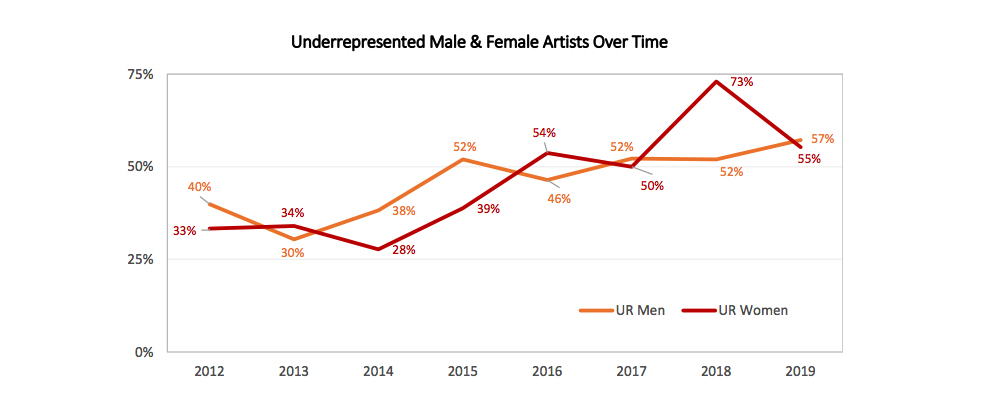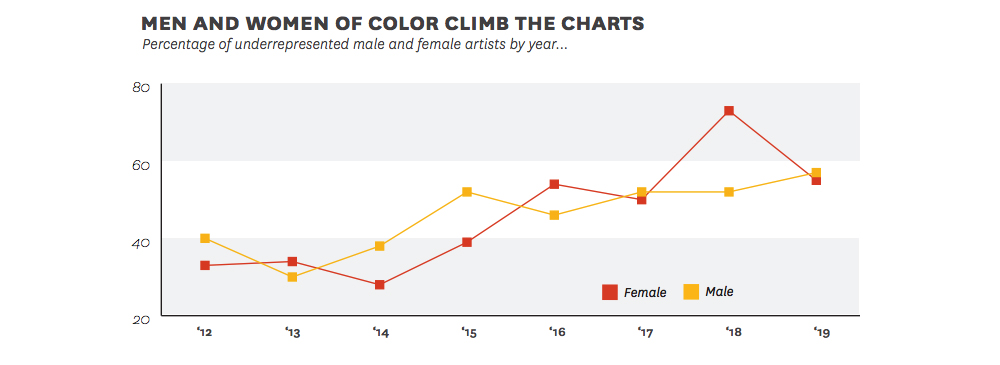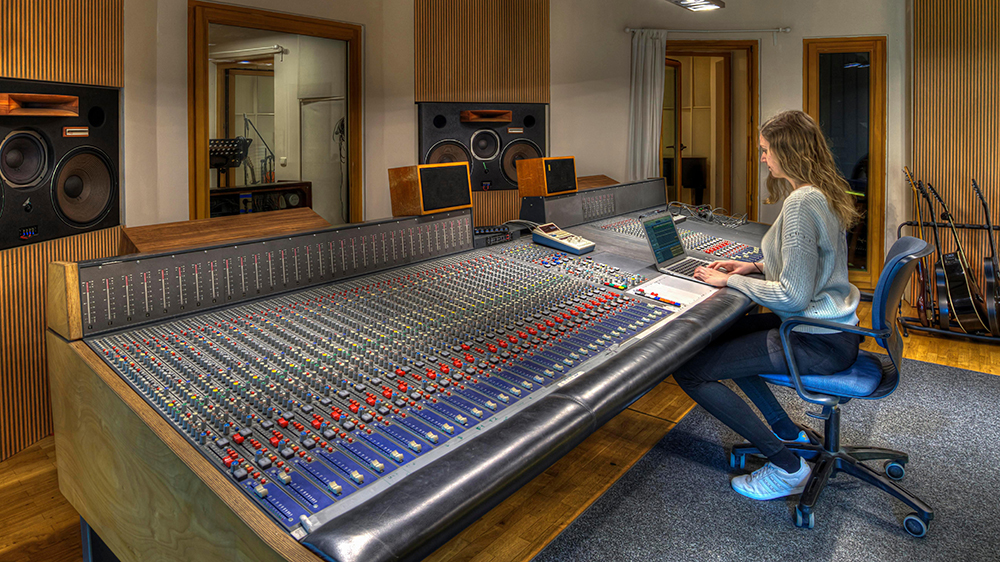People of Color Fare Better in Music, ‘A Stark Contrast From Film Industry,’ Study Finds
By Variety Staff
LOS ANGELES (Variety.com) – The latest USC Annenberg Inclusion Initiative study, titled Inclusion in the Recording Studio?, was released today, the third authored by Dr. Stacy L. Smith.
Among its findings: Female songwriters now count for 14.4% of the most popular songs, up from 11.6% in 2018. Even still, more than half (56.4%) of the 800 songs examined by the study did not credit one woman as a songwriter. Less than one percent of all 800 songs featured only female writers. Of producers, women number 2.6 percent, half of the previous year, with eight out of 1,093 producing credits going to women of color.
And looking over a period of eight years, the top two male songwriters (Max Martin and Drake) have twice as many songwriting credits than the two top female songwriters (Nicki Minaj and Rihanna — though as artists, Minaj and Rihanna are second behind across genders with 21 songs each).
Faring slightly better among artists, women make up 21.7% of charting acts. Another bright side: more than half of charting acts in 2019 were people of color (56.1%).
The study was funded by Spotify and analyzed artists and content creators across 800 popular songs on the Billboard Hot 100 year-end charts from 2012 to 2019 as well as gender for eight years of Grammy nominations, specifically in the categories of record of the year, album of the year, song of the year, producer of the year, and best new artist.
In a statement detailing its findings, Selena Gomez reveals that, upon joining the Recording Academy’s Diversity and Inclusion Task Force a year ago, she pledged to create opportunities for women in music. Said Gomez: “While recording my new album [‘Rare’], I wanted to ensure there were women involved in the creative process. I feel proud that women were essential collaborators on every song whether as a songwriter, producer, or engineer. It’s a start, but there is much work to be done to amplify women’s voices in our business.”
“The music industry has virtually erased female producers, particularly women of color, from the popular charts,” said Dr. Smith. “As producers fill a leading creative role, it’s essential to ensure that women from all backgrounds are being considered and hired throughout the industry. Moreover, the industry itself must continue to expand its commitment to representing the voices and talent of women in all aspects of the business.”
The report goes on to emphasize the need to “[ensure] that the recording studio is viewed and functions as a workplace itself — rather than a creative environment to sexualize and stereotype women” as “the first major step toward increasing females’ participation.”
Smith continued: “Women are still missing from popular music. Yet we do see that the music industry values women of color and their contributions. In 2019, over half of the female artists on the popular charts were women of color. This is in stark contrast to what we see in the film industry.” (According to a report about the movie industry , the percentage of underrepresented directors was 16.8% in 2019, a dip from 2018’s high of 21.4%.)
To that end, the study notes that unlike film and television, the top three artists in music were all from underrepresented racial/ethnic groups, and more broadly, half of the 18 top performers are underrepresented and half are white.
As far as the Grammy Awards are concerned, 2020 marks an eight-year high in female nominees, which made up 20.5% of the categories evaluated, thanks in no small part to the dominance of Lizzo and Billie Eilish. Not surprisingly, the producer of the year category is a virtual desert for female nominees, with only one woman, Linda Perry, having been nominated during the study’s time range.
The categories in which female nominees are most likely to be nominated are best new artist category, followed by song of the year. Less than 10% of nominees in the record or album of the Year categories were female.
Gender-wise, the most egregious gap was found in the alternative format where as only 11% of artists were women, outnumbered by males 8.1 to 1. Dance/Electronic and pop were found to be the most female-friendly genres, with women claiming 20% of the songwriting credits. Hip-hop and rap were most exclusionary.
In her recommendations for change, Dr. Smith highlighted that “it is crucial for industry members to question their biases.” In addition, she listed the following: View every song as an opportunity; create a culture of belonging; and support existing efforts to increase inclusion in music.
See more interesting insights below and head to the Annenberg site for the complete report :
Artists by Gender in 2019
Males: 78.3%
Females: 21.7%
Ratio: 3.6 to 1
Percentage of Female Artists by Performer Type in 2019:
Individual: 27.3%
Duo: 16.7%
Band: 3.4%
Top Male Solo Artists from 2012 – 2019:
Drake: 37 songs
Justin Bieber: 14 songs
Chris Brown: 14 songs
Calvin Harris: 11 songs
Kendrick Lamar: 11 songs
Bruno Mars: 11 songs
The Weeknd: 10 songs
Post Malone: 10 songs
Ed Sheeran: 10 songs
Top Female Solo Artists from 2012 – 2019:
Rihanna: 21 songs
: 21 songs
Ariana Grande: 16 songs
Taylor Swift: 14 songs
Cardi B: 12 songs
Selena Gomez: 10 songs
Katy Perry: 9 songs
Adele: 8 songs
Meghan Trainor: 7 songs
Top Individual Male Songwriters
Martin Sandberg (Max Martin): 43 credits
Aubrey Graham (Drake): 38 credits
Benjamin Levin (Benny Blanco): 25 credits
Henry Walter (Cirkut): 23 credits
Savan Kotecha: 23 credits
Lukasz Gottwald (Dr. Luke): 21 credits
Johan Schuster (Shellback): 21 credits
Dijon McFarlane (DJ Mustard): 16 credits
Jacob Hindlin (JKash): 15 credits
Mikkel Eriksen and Tor Hermansen (Stargate): 15
Top Individual Female Songwriters
Onika Maraj (Nicki Minaj): 19 credits
Robyn Fenty (Rihanna): 14 credits
Taylor Swift: 14 credits
Belcalis Almanzar (Cardi B): 12 credits
Ariana Grande: 10 credits
Katheryn Hudson (Katy Perry): 9 credits
Adele Adkins (Adele): 8 credits
Sia Furler (Sia): 8 credits
Selena Gomez: 8 credits
Brittany Hazzard (Starrah): 8 credits




